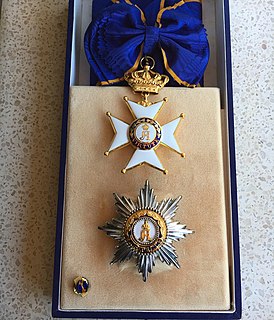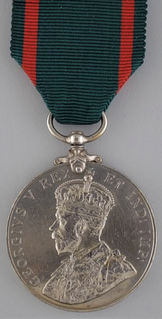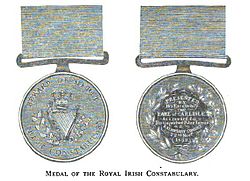The British honours system is a means of rewarding individuals' personal bravery, achievement, or service to the United Kingdom and the British Overseas Territories. The system consists of three types of award – honours, decorations and medals:

Harald V is the King of Norway, having ascended the throne upon the death of his father King Olav V on 17 January 1991.

The Order of Merit is a Commonwealth order of merit recognising distinguished service in the armed forces, science, art, literature, or for the promotion of culture. Established in 1902 by King Edward VII, admission into the order remains the personal gift of its Sovereign—currently Edward VII's great-granddaughter, Queen Elizabeth II—and is restricted to a maximum of 24 living recipients from the Commonwealth realms, plus a limited number of honorary members. While all members are awarded the right to use the post-nominal letters OM and wear the badge of the order, the Order of Merit's precedence among other honours differs between countries.

The Distinguished Conduct Medal, post-nominal letters DCM, was established in 1854 by Queen Victoria as a decoration for gallantry in the field by other ranks of the British Army. It is the oldest British award for gallantry and was a second level military decoration, ranking below the Victoria Cross, until its discontinuation in 1993 when it was replaced by the Conspicuous Gallantry Cross. The medal was also awarded to non-commissioned military personnel of other Commonwealth Dominions and Colonies.
The Order of the Crown is a national order of the Kingdom of Belgium. The Order is one of Belgium's highest honors.

The Conspicuous Gallantry Cross (CGC) is a second level military decoration of the British Armed Forces. Created in 1993 and first awarded in 1995, it was instituted after a review of the British honours system to remove distinctions of rank in the awarding of gallantry decorations. The Victoria Cross is the only higher combat gallantry award presented by the United Kingdom.

The Order of the Redeemer, also known as the Order of the Saviour, is an order of merit of Greece. The Order of the Redeemer is the oldest and highest decoration awarded by the modern Greek state.

The Order of Civil and Military Merit of Adolph of Nassau is an order of merit of the Grand Duchy of Luxembourg for meritorious service to the Grand Duke, the Grand-Ducal House and Luxembourg. It was founded in 1858 as a chivalric order of the Duchy of Nassau by Adolphe of Nassau in honor of his namesake and ancestor, Adolf, Count of Nassau, the only member of the House of Nassau to have been Roman King of Germany. After the Duchy of Nassau was annexed by Prussia in 1866 and Adolphe became Grand Duke of Luxembourg in 1890, he revived the order as an order of merit.
The Royal Victorian Medal (RVM) is a decoration established by Queen Victoria in April 1896. On 14 May 1912, King George V further confirmed the institution of the medal with an additional royal warrant. A part of the Royal Victorian Order, it is a reward for personal service to the Sovereign or the royal family, and is the personal gift of the sovereign. It differs from other grades of the order in appearance and in the way it is worn.

The Naut Tahrir al-Kuwait was instituted by King Fahd ibn Abdulaziz of Saudi Arabia for service during the Liberation of Kuwait campaign.

The King's Medal of Merit is a Norwegian award. It was instituted in 1908 to reward meritorious achievements in the fields of art, science, business, and public service. It is divided in two classes: gold and silver. The medal in gold is rewarded for extraordinary achievements of importance to the nation and society. The medal in silver may be awarded for lesser achievements. The medal is suspended from a ribbon in the colours of the Royal Standard of Norway.

The Efficiency Decoration, post-nominal letters TD for recipients serving in the Territorial Army of the United Kingdom or ED for those serving in the Auxiliary Military Forces, was instituted in 1930 for award to part-time officers after twenty years of service as an efficient and thoroughly capable officer. The decoration superseded the Volunteer Officers' Decoration, the Colonial Auxiliary Forces Officers' Decoration and the Territorial Decoration.

The Order of Agricultural Merit is an order of merit bestowed by the French Republic for outstanding contributions to agriculture. When it was created in 1883, it was second in importance only to the Legion of Honour within the French order of precedence.

The Queen Elizabeth II Diamond Jubilee Medal or The Queen's Diamond Jubilee Medal is a commemorative medal created in 2012 to mark the sixtieth anniversary of Elizabeth II's accession to the thrones of the Commonwealth realms. There are three versions of the medal: one issued by the United Kingdom, another by Canada, and the third for the Caribbean realms of Antigua and Barbuda, the Bahamas, Barbados, Grenada, Jamaica, Saint Kitts and Nevis, Saint Lucia, and Saint Vincent and the Grenadines. The ribbons used with the Canadian and British versions of the medal are the same, while the ribbon of the Caribbean medal differs slightly. The different iterations of the medal were presented to tens of thousands of recipients throughout the Commonwealth realms in the jubilee year.

The New Zealand General Service Medal 2002 (Afghanistan) is a campaign medal of New Zealand that recognizes service in the War in Afghanistan. The Queen of New Zealand authorized the creation of a new General Service Medal for the recognition of service taking place after December 2001 with a royal warrant on 23 July 2002. Regulations to establish the NZGSM 2002 (Afghanistan) were published 16 January 2003.

The Burma Gallantry Medal (BGM) was a military decoration awarded to non-commissioned Officers and other ranks of the British Burma military, Frontier Force and military police for acts of personal bravery in war or peace. Established by royal warrant in 1940, it was first awarded 26 March 1942 and last awarded 28 November 1947.
The Military Medal For Gallantry (MMG) is a military decoration awarded by the Government of Ireland. It is the highest award of the military awards and decorations of Ireland.

The Special Constabulary Long Service Medal is long service medal awarded in the United Kingdom to members of the Special Constabulary who have completed a specified period of service. Established in 1919 by King George V, the medal was initially created to reward members of the Special Constabulary for their service during World War I.

The Colonial Special Constabulary Medal was established on 1 April 1957 as a volunteer and part-time long service medal of the United Kingdom and the Commonwealth. On 10 April 2012 the medal became known as the Overseas Territories Special Constabulary Medal, and underwent a minor change in design. This reflected the change in the way Britain's remaining colonies were described, they being classed as 'Overseas Territories' from 2002.

King George V’s Visit Police Commemoration Medal 1911 (Ireland), more commonly referred to as the Visit to Ireland Medal 1911, was awarded to those members of the Irish Police Forces on duty during the various engagements of King George V’s visit to Ireland in 1911.

















